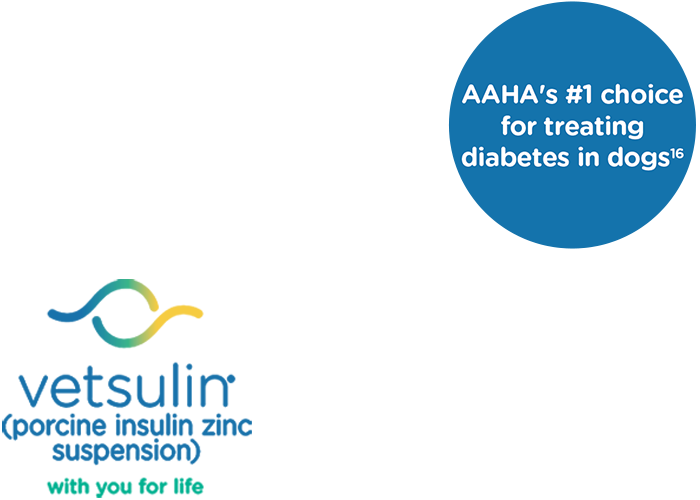

Diagnosis & Management
Read More About Canine Diagnosis & Management
Diagnosing Canine Diabetes
Diabetes mellitus is not the only cause of polyuria/polydipsia and weight loss. Each dog should be examined thoroughly to rule out any other causes before starting insulin management. A preliminary diagnosis of diabetes mellitus based on clinical signs must be confirmed by blood and urine tests. Reference values for blood glucose range from 80–120 mg/dL (4.4–6.7 mmol/L) in dogs. The renal threshold is around 180 mg/dL (10 mmol/L). If the blood glucose concentration exceeds this threshold, glucose is excreted in the urine.
Healthy Diabetes Management
The goals in managing diabetes mellitus are to minimize the clinical signs of diabetes, the risk of hypoglycemia, and the development of long-term complications. Accomplishing these goals requires that dog owners understand all aspects of diabetes management. Investment of sufficient time in a careful explanation of all of the aspects of the therapy is strongly recommended.
Managing diabetes can be an exercise in frustration until stabilization occurs; however, there are tools available to help evaluate the disease and its management, and there are resources available through this website to provide additional support. Insulin forms one of the cornerstones of the management of diabetes mellitus; therefore, it is important to understand the length of action of insulin and how to evaluate management.
Evaluation of Management
Monitoring blood glucose is a good way to evaluate regulation of a dog with diabetes. It is accurate, rapid, and requires only a drop of blood. However, in certain conditions (see below), it is not reliable because blood glucose concentration is influenced by many factors. Consequently, blood glucose curves may not show the actual result of the insulin treatment.
Various factors such as economics, logistics, and clinical situations can also force veterinarians to limit diagnostic procedures. When it is not possible to perform a complete glucose curve, spot glucose measurement combined with clinical signs, general observations, and evaluating glycosuria can provide an overview of the animal. Veterinarians can also rely on evaluation of glycosylated hemoglobin (HbA1c) and fructosamine in laboratory testing.
Available management tools:
- Glucose curves
- Spot glucose measurements
- Evaluation of glycosuria and monitoring
- Clinical signs
- Glycosylated fructosamine and HbA1c?
Certain Conditions
Food intake, exercise, dog cooperation, use of a drug (eg, xylazine, dexmedetomidine, prednisolone, progestogens, megestrol acetate), and other conditions (eg, hyperadrenocorticism, acromegaly), or stress can affect blood glucose levels. In these cases, therefore, their presence should be considered when making treatment decisions.
Help Your Practice Manage Diabetes Mellitus
View and download resources and tools that will assist your hospital, inform your team, and help with clients.

Blood Glucose Curve Generator
Create a blood glucose curve to monitor and evaluate diabetes treatments.

Client Discharge Form
Create a customized, printable form for clients about their new diagnosis.

Diabetes Resources
Access online tools and more to support staff and pet parents.
No items to show.
Read More About Canine Diagnosis & Management
Important Safety Information:
Vetsulin® should not be used in dogs known to have a systemic allergy to pork or pork products. Vetsulin is contraindicated during periods of hypoglycemia. Keep out of reach of children. As with all insulin products, careful patient monitoring for hypoglycemia and hyperglycemia is essential to attain and maintain adequate glycemic control and prevent associated complications. Overdosage can result in profound hypoglycemia and death. The safety and effectiveness of Vetsulin in puppies, breeding, pregnant, and lactating dogs has not been evaluated. See package insert for full information regarding contraindications, warnings, and precautions.
References:
1. Martin GJ, Rand JS. Pharmacology of a 40 IU/ml porcine lente insulin preparation in diabetic cats: findings during the first week and after 5 or 9 weeks of therapy. J Feline Med Surg. 2001;3(1):23–30. 2. Vetsulin® (porcine insulin zinc suspension) [Freedom of Information Summary]. Millsboro, DE: Intervet Inc.; 2008. 3. Data on file, Merck Animal Health. 4. Graham PA, Nash AS, McKellar QA. Pharmacokinetics of porcine insulin zinc suspension in diabetic dogs. J Small Anim Pract. 1997;38(10):434–438. 5. Martin GJ, Rand JS. Pharmacokinetic and Pharmacodynamic Study of Caninsulin in Cats with Diabetes Mellitus. 2000: Internal Study Report. 6. Feldman EC, Nelson RW. Canine and Feline Endocrinology and Reproduction. 3rd ed. St. Louis, MO: Saunders; 2004:539–579. 7. Tennant B, ed. BSAVA Small Animal Formulary. 4th ed. Gloucestershire, UK: British Small Animal Veterinary Association; 2002. 8. Feldman EC, Nelson RW. Canine and Feline Endocrinology and Reproduction. 3rd ed. St. Louis, MO: Saunders; 2004:486–538. 9. Reusch C. Feline diabetes mellitus. In: Ettinger SJ, Feldman EC, eds. Textbook of Veterinary Internal Medicine. 7th ed. St. Louis, MO: Saunders; 2010:1796–1816. 10. Nelson RW. Canine diabetes mellitus. In: Ettinger SJ, Feldman EC, eds. Textbook of Veterinary Internal Medicine. 7th ed. St. Louis, MO: Saunders; 2010:1782–1796. 11. Burgaud S, Riant S, Piau N. Comparative laboratory evaluation of dose delivery using a veterinary insulin pen. In: Proceedings of the WSAVA/FECAVA/BSAVA congress; 12–15 April 2012; Birmingham, UK. Abstract 121. 12. Burgaud S, Guillot R, Harnois-Milon G. Clinical evaluation of a veterinary insulin pen in diabetic dogs. In: Proceedings of the WSAVA/ FECAVA/BSAVA congress; 12–15 April 2012; Birmingham, UK. Abstract 122. 13. Burgaud S, Guillot R, Harnois-Milon G. Clinical evaluation of a veterinary insulin pen in diabetic cats. In: Proceedings of the WSAVA/FECAVA/BSAVA congress; 12–15 April 2012; Birmingham, UK. Abstract 45. 14. Davison LJ, Walding B, Herrtage ME, Catchpole B. Anti-insulin antibodies in diabetic dogs before and after treatment with different insulin preparations. J Vet Intern Med. 2008;22:1317-1325. 15. Banfield State of Pet Health 2016 Report. p 12-13. 16. Behrend E, Holford A, Lathan P, Rucinsky R, Schulman R. 2018 AAHA Diabetes management guidelines for dogs and cats. J Am Anim Hosp Assoc. 2018; 54:1–21.
